Investigating the Essential Elements That Influence Luminance in Light Emitting Diode Display Screens
Investigating the Essential Elements That Influence Luminance in Light Emitting Diode Display Screens
Blog Article
LED panel screens are progressively favored for and promotion and leisure due to their bright and vivid images. Grasping the factors that influence the brightness of these panels is crucial for manufacturers and consumers alike. Brightness is typically measured in nits, which indicates how much light is produced from the area of the screen. Numerous key factors affect to the overall luminosity, including the kind of LED used, the quality of the panel materials, and the power supplied to the panel.
The type of Light Emitting Diode component used in a wall panel plays a crucial role in its brightness. Different LEDs produce varying levels of light output, which gauge the amount of light perceptible to the human eye. Premium chips, such as those made using advanced technology, can generate brighter illumination with higher efficiency. Furthermore, the color tone of the LED also affects apparent brightness. For instance, cooler color tones (higher Kelvin values) can seem more luminous than warmer ones, even at the same light output rating. This feature is important for uses where visibility is important, such as in external promotion.
The materials used in the construction of Light Emitting Diode panel screens also affect their brightness. The kind of substrate and encapsulation materials can influence how much light is transmitted versus how much is taken in or scattered. For example, a screen made with high-quality optical material will allow more illumination to flow through than one made with lower-grade materials. Additionally, the configuration of the panel, including its depth and the layout of the LEDs, can improve or diminish brightness by influencing how illumination is distributed across the panel.
The power source provided to the LED panel screens is another critical element in determining brightness. Each LED component has a particular voltage and electric flow need for optimal performance. If the power supply falls short, the luminosity of the screen will decrease. Conversely, supplying too much power can lead to overheating and reduced lifespan of the visit this web-site Light Emitting Diodes. Therefore, ensuring a consistent and sufficient energy source is crucial for realizing uniform luminosity levels. This is especially vital in changing screens, where brightness may need to be adjusted for different lighting conditions.
Lastly, surrounding elements can influence how luminosity is perceived. Surrounding light conditions play a major role in how bright an LED panel panel looks. In luminous daylight, for example, a panel with a lower luminosity rating may have difficulty to be seen clearly, while a higher-brightness screen can stand out more efficiently. Additionally, the perspective from which the screen is viewed can influence luminosity perception due to how light bounces off surfaces. Understanding these elements helps buyers select the right Light Emitting Diode wall panel for their requirements and ensures that producers produce led video wall graphics products that satisfy brightness standards for different uses.